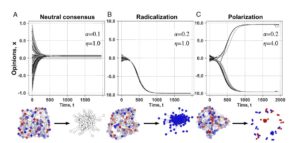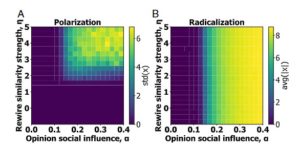Introduction
Homophily, as we learned in the course, is a concept which states that similar individuals tend to stick together and act in similar ways (“birds of a feather flock together”). While making friends in person could be driven by homophily (age, gender, etc.), making connections with people online, whom we have never met is largely left to the mercy of algorithms such as PYMK. While these algorithms employ advanced techniques such as ML, neural networks, etc. to gauge our similarities to others, at the base of these algorithms is usually the idea that structurally similar nodes (common neighbors, etc.) are more likely to form links.
In this post, I will be summarizing the findings of an academic paper that introduces a graph model where links are primarily formed using structural similarity and shows how even this “simple” notion can lead to polarization in a network. The authors acknowledge the fact that the idea of forming connections based on similar neighbors, triadic closures, etc. predates online platforms and state that their research shows how algorithms such as PYMK can exacerbate formation of echo chambers/isolated groups/polarization in conjunction with the homophily that individuals exhibit.
Intuition of the graph model
- Each individual i is described by an opinion, either positive or negative dictating their viewpoint on one matter
- Capturing structural similarity is proportional to the number of common neighbors with a controlled variable n which determines how much the structural similarity impacts formation of new links
- Updating opinion of node’s is done via calculating the average opinion of direct neighbors and a controlled variable a which determines how much a node is influenced by others (if a=0 then a node’s influence is not impacted by neighbors even if the opinion is “radical” – high positive or negative)
Results of simulations
The experiment begins with generating a random graph with nodes that have random opinions (assigned either positive/negative numbers) and random links. The links over time t = 0 to t = 2000 may change/diminish and structure of the network changes drastically depending on the social influence a and structurally similar links n described earlier. At each time step, the graph is rewired based on structurally similarity and one’s social influence on other over their opinions.


Final thoughts
The results and findings of this study into modelling PYMK algorithmic behaviour act like a pseudo proof that link forming algorithms are bound to create divide and radical polarization of communities over any social network.
The results do not even take into account techniques that model an individual’s psyche using their internet data/traffic to further connect them to even similar individuals, strengthening the homophily affect.
The academic paper stands unique to many others in the sense that while most other papers calculated the effect of link rewiring on each time step based on opinion similarity, this paper disregards homophily and only focuses on network topology to draw a conclusion that proves the foundational downside of using algorithms such as PYMK
some Omitted details
- Results in each of the figures are the average of 100 independent runs where the simulation started using a random graph model much like erdos renyi graph model (Gnp) we learned in class, specifically Watts–Strogatz small-world network
- The graph model itself uses a lot of mathematical formulas to predict and model PYMK algorithms based on network topology/structure. Example: The social influence controlled variable a has a particularly interesting model formula that uses a tangent function, and a lot of other interesting math formulas to capture PYMK behaviour which can be found under the “Materials and Methods” section in the source
Source
Santos, F. P., Lelkes, Y., & Levin, S. A. (2021, December 6). Link recommendation algorithms and dynamics of polarization in online social networks. Princeton University. Retrieved October 4, 2022, from https://princeton-staging.pure.elsevier.com/en/publications/link-recommendation-algorithms-and-dynamics-of-polarization-in-on